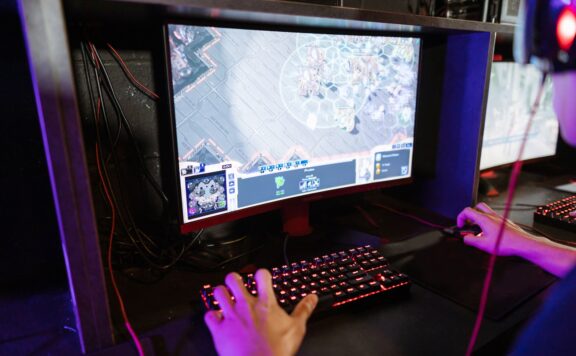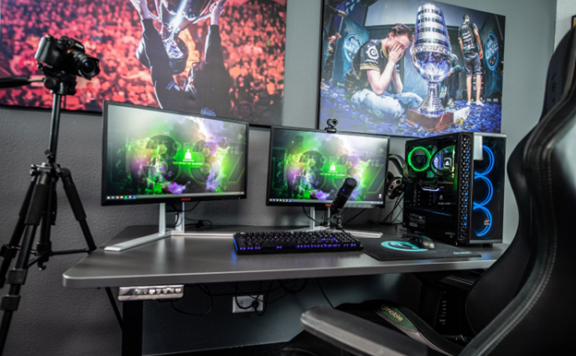Performance is everything when gaming, so we tried to add water cooling to our mobile phone. It seemed like a great idea at the time.
We all know that the very bleeding edge of gaming generates some serious heat blowback. Whether it’s the latest console with some fancy new polygons or a PC with a honking great fan mounted to the CPU, there are plenty of ways to keep cool during the most intense scenarios. With on the go gaming becoming more and more demanding, top end mobile gaming phones are even incorporating liquid cooling solutions into pocket sized personal computers to squeeze out every last frame of on the go performance. Hence our urge to go all DIY with some water cooling for mobile gaming.
Just Let It Burn?
Unfortunately, devices like the Lenovo Legion Duo and ROG series are far from the norm and when we grabbed the Moto G200 back last year, it performed admirably. However, given the plastic back and lack of a dedicated cooling solution, the entire device gets decidedly hot during extended stress testing. As anybody who has balanced a piping hot laptop on their knees can attest, this trapped heat is the enemy of efficiency. So, we decided to see if we could squeeze every extra frame of performance by water cooing our handled gaming sessions.
As the resources required to simply keep titles like Genshin Impact and Torchlight Infinite chugging along smoothly seems to creep up, the heat generated by our plastic fantastic phone gradually aims ever upwards. Handsets that feature powerful processors but no way to dispose of that heat face a number of issues. At the most basic level, electronics that heat up too much change their basic properties. Heat increases resistance, meaning that just getting electricity to flow becomes a problem. Aside from simply melting into silicon slag, the chips inside a phone or computer will begin to slow down as electricity simply doesn’t flow through innumerable microscopic switches quite the same. Manufacturer’s deal with this in a number of ways. A common approach is to actively slow down the speed of a chip before it overheats, while roomier rigs can cram in active fans and water blocks to help move the heat somewhere else.
Phones will tend to dump a bunch of this heat out the forward facing glass screen and surrounding case. For a phone like the Moto G200 that becomes an issue. The Snapdragon 888+ chipset is utterly overpowered for its format. Like a hotrod, the engine is way too big for the rest of the chassis ands putting the pedal to the metal means things get toasty pretty quickly..

We tested the Moto G200 using 3D Mark to provide initial performance testing and longer term stress testing. The 3D Mark Wildlife test results above show that the bare bones phone managed a score of 5648 at 33.80 FPS
Mobile Matters
So, what do you do when you’ve got a game where every single frame is crucial? You squeeze every ounce of performance out of the underlying hardware. On a desktop this requires top tier cooling? That could mean dipping into water cooling, the gamer’s premium option when keeping heat at bay and looking cool. Mobile phones, however, aren’t exactly built to be taken to pieces and attached to a radiator. Thanks to some shelf scouring over at AliExpress we were able to get our hands on a bolt-on alternative from manufacturer Palmtoy. A seemingly perfect pick when water cooling for mobile gaming.

Instead of clamping a cooling solution directly onto a phone processor, this water cooling setup bolts onto the back of any reasonably sized phone. This straight forwrd pump and reservoir system, attached to a cold plate that should help sap heat away from our test mobiles when things get dicey, or that is the idea.
The ‘Cooling Pad’ clamps together easily enough and while using simple cold tap water at 12 degrees Celsius / 54 F, we ran the very same 3D Mark Wild Life as above. The results are below.
As you can see, just adding any external path for heat to escape seems to make a definitive difference on the overall performance of the Moto G200. The baseline test certainly is a lower score than this actively cooled solution, but the jump is almost negligible for a daily hefty piece of plastic, a reservoir, and a pump that requires a 5V power source. So, we got looking for something that fits the mobile gamer a little better.
All Hot Air
While it works, the water cooling solution we found is far from a great fit. The sizeable cold plate will work for plenty of devices, but heat spots close to the G200’s camera bumps meant getting a flush fit between the metal back and the hot phone back could be difficult.
After managing to wrangle the water cooler off the back of a test phone, it seems the logistics of water cooling will keep it firmly placed in the front room. An oversized battery pack, a bulky reservoir, and the potential for a wet mess make Windows Subsystem for Android or Bluestacks a better option for high performance mobile games, until we took a simpler approach. Before RGB enhanced piping and neon laced coolant snaked its way around desktop PCs, the humble air cooler was already pretty capable. These days, there’s little difference between the performance of the two options when you’ve got enough air flow, and this is where a slimmed down Black Shark mobile cooler comes into play.

The Black Shark Gaming Cooler takes the same concept as the earlier water cooling system and straps a cold plate to the back of a phone, swapping out the pump for old fashioned air flow. This generic bit of kit will clamp onto most phones and draw power via a USB C cable. It’s available from the Xiaomi gaming spin off for around $19 and the motor simply draws ambient air over the exterior end of this device and off out into the room. It’s almost rudimentary and starts at the bottom end of Black Shark’s cooler portfolio but has some obvious advantages to the cumbersome alternative. The comparably small footprint of this device means that wrestling it over the hottest part of any phone should be far easier than the girthy water cooled contraption, while power draw can even come straight from the phone.
Results
We ran both a Wild Life and Wild Life Stress Test, with the following numbers.
Initial results using air cooling come in at 5712. This seems imperceptibly different from the initial result of 5719 in our water cooled trial, providing a reasonable alternative in the short term. Stress testing also seems to show a larger gap given time, yet the highest loop score is just a few hundred points lower than using a liquid contraption.
Even inspecting the frames per second and temperature in more detail, both the liquid and air cooling performance are close enough that air cooling doesn’t seem to suck. While our measure of 3D mark scores isn’t a definitive or direct check on polling rate or in game performance, it certainly suggests that while after market water cooling for mobile gaming can do the job, good old air is a more practical augmentation. Either of these external coolers only clawed back around a 15% frame rate uplift but whether you’re looking to come out on top at Fortnite or loot as fast as possible when looting in Fortnite, then a new blower might be in order.











